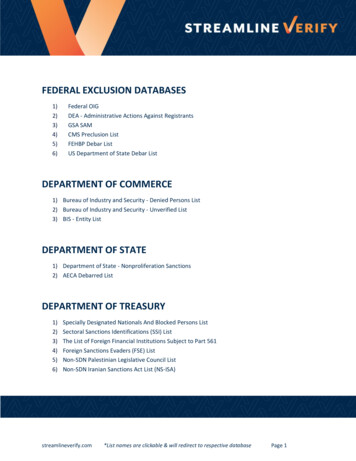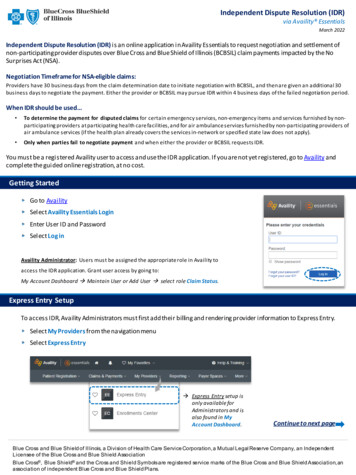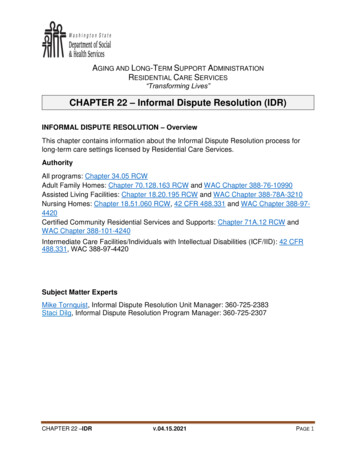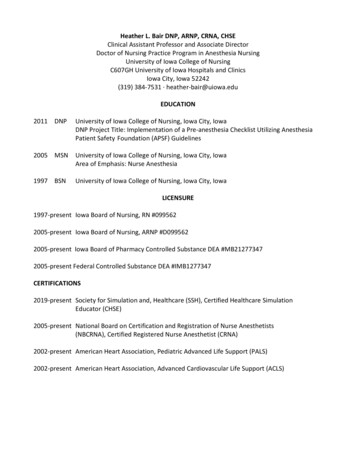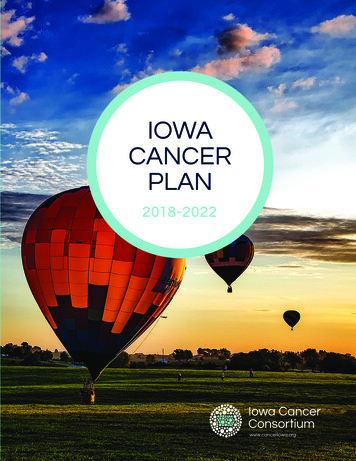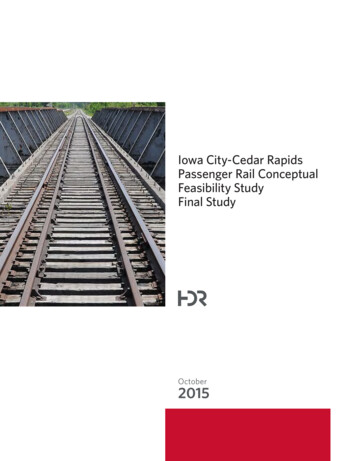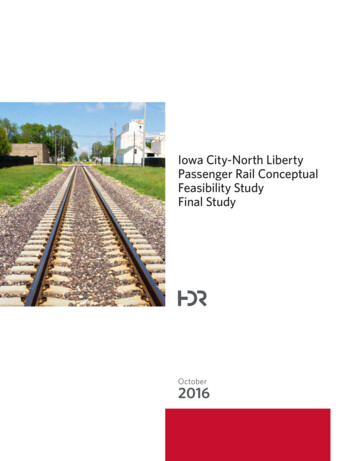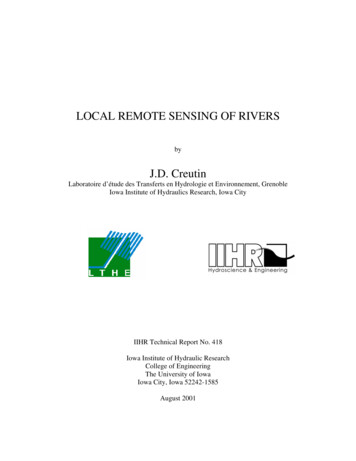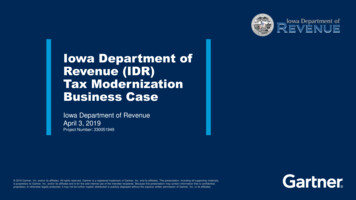
Transcription
Iowa Department ofRevenue (IDR)Tax ModernizationBusiness CaseIowa Department of RevenueApril 3, 2019Project Number: 330051949 2018 Gartner, Inc. and/or its affiliates. All rights reserved. Gartner is a registered trademark of Gartner, Inc. and its affiliates. This presentation, including all supporting materials,is proprietary to Gartner, Inc. and/or its affiliates and is for the sole internal use of the intended recipients. Because this presentation may contain information that is confidential,proprietary or otherwise legally protected, it may not be further copied, distributed or publicly displayed without the express written permission of Gartner, Inc. or its affiliates.
Table of Contents1. Background2. IDR Current State Analysis3. Gap Analysis4. Options Analysis5. Recommendation & Benefits6. Next StepsINTERNAL or RESTRICTED1 2018 Gartner, Inc. and/or its affiliates. All rights reserved. Gartner is a registered trademark of Gartner, Inc. and its affiliates.
Gartner, Inc. was chosen to support IDR because it is the world’sleading authority on the business of IT with a 39-year history Gartner has worked with numerous federal, state, and local agencies to develop strategies for digital modernization, including enterprisetax and revenue systems. Gartner has no economic interests in any hardware, software, or system integration vendors, providing unparalleled objectivity in itsanalyses and eliminating the biases found in other consultancies.Gartner DifferentiationProof PointsIDR GoalsGuiding IDR to make informed decisions onincreasing their ability to meet rising demands. Project approach designed to produce supporting consensus. Project approach designed to link recommendations to objectives which matter to institutionalleadership.SolutionMethodologies based on independent insight ina digital age. Tools embody best practices developed across thousands of similar projects. Reflects Gartner Research’s up-to the minute knowledge of the tax processing system marketand tax revenue agency trends.PeopleSeasoned experts that have mitigated risks anddriven success for your peers. 20 Years working with global tax revenue agencies. 10 Years working with tax processing systems. Project team members who understand the unique processes and culture of tax revenueagencies.BrandPower of Gartner research, independence andobjectivity. Largest IT research database (110,000 reports). Global community of 1,000 research analysts, 60% of who are hired with 20 years ofexperience. Only IT and business Consulting firm with an Office of the Ombudsman to ensureindependence.BenchmarkingAbility to measure, optimize and transform. The industry’s largest IT repository, drawn from 5,000 benchmarks annually.INTERNAL or RESTRICTED2 2018 Gartner, Inc. and/or its affiliates. All rights reserved. Gartner is a registered trademark of Gartner, Inc. and its affiliates.
IDR is responsible for tax administration in the State of IowaWhat does IDR do? IDR’s mission is to serve Iowans and support state government by collecting all taxes required by law, but no more. In FY 2017, IDR collected over 10.1B in taxes and issued 1.2B in refunds to taxpayers resulting in net deposits of 8.9B to the State. InFY 2017, IDR processed over 2.5M tax returns.Recommended Scope for Analysis Individual Income Tax / Withholding, Consumer’s Use Tax, Fuel Taxes, Corporation Income Tax, Retailer’s Use Tax, Franchise Tax, Hotel /Motel Tax, Inheritance Tax / Fiduciary Tax, Sales Tax, Local Option Sales Tax, Cigarette / Tobacco Tax, Replacement Tax, E911 SurchargeFee, Hazardous Materials Permit Fee, Property Tax, Insurance Premium Tax, Real Estate Transfer Tax, One-Time Fee for New VehicleRegistration, Car Rental Tax & Vehicle Title Surcharge and Miscellaneous other Taxes. All tax processes including taxpayer registration, electronic filing (modern eFile and streamlined sales tax), paper filing, receipt and issuanceof payments and refunds, taxpayer self-help, processing returns and payments, return resolution, processing refunds and offsets,compliance, appeals, tax credit transfers and claims, local government data exchange, revocations, collections, taxpayer customer serviceand tax data analysis. Collections of debt for other Iowa State Agencies, Counties and Cities.INTERNAL or RESTRICTED3 2018 Gartner, Inc. and/or its affiliates. All rights reserved. Gartner is a registered trademark of Gartner, Inc. and its affiliates.
IDR serves eight constituency groupsEach constituency group requires tailoredservices to meet their respective needs.Tax ProfessionalsProfessionals whoare qualified tocalculate, file &Businesssign incomeIDR StaffTaxpayerstax returns onProfessionals thatBusiness entitiesbehalf ofsupport IDR’sthatderive incometaxpayersmissionfrom IowaElectedOfficials andtheir StaffState leaders andstaff that utilize IDRdata to help theirconstituentsIowaDepartmentof RevenueOtherGovernmentAgenciesBulk Filers3rd-partywhoperforms taxreporting andpaying servicesfor multipleclientsIndividualTaxpayersCitizens or legalAdministration of stateLocalresidents thatand federalderiveGovernmentsagenciesAdministration ofincomea town, county orfromdistrictIowaINTERNAL or RESTRICTED4 2018 Gartner, Inc. and/or its affiliates. All rights reserved. Gartner is a registered trademark of Gartner, Inc. and its affiliates.
Modern tax systems are more streamlined and modularIndividualBusinessCPA/ Agent/ Bulk FilerLocal Gov’tsEnterprise PortalIDR StaffMobile Friendly User InterfaceA secure unified access point, [e.g. web user interface) that is designed to presentpersonalized, aggregated info to the userUser Interface(UI) LayerBrowser Based User InterfaceOther AgenciesAccounts ModuleProduction Internal Operations Tax processingsystems Accounting systemsfor taxes Business rules engine Workflow engine Content Management Integration platform Database and ETL toolsEnterprise IntegrationPlatformFilings and Payments ModuleRefunds and Distribution ModuleCompliance and Collections ModuleInterfaces Shared boundarywhich shares dataamongst all modulesINTERNAL or RESTRICTED5 2018 Gartner, Inc. and/or its affiliates. All rights reserved. Gartner is a registered trademark of Gartner, Inc. and its affiliates.Portal StoragePortalDatabasePortal ContentRepositoryData LayerEnabling TechnologyCredits ModuleApplicationLayerOther Agency Systemsand 3rd Party SystemsSingle Sign-on / Identity and Access Management
Gartner used a three-phase approach to develop this business caseIdentified the gapsbetween IDR’scurrent state andrecommendedpractices for amodern integratedtax processingsystemThree-phase Approach toDevelop Business CaseINTERNAL or RESTRICTED6 2018 Gartner, Inc. and/or its affiliates. All rights reserved. Gartner is a registered trademark of Gartner, Inc. and its affiliates.
Current State analysis finds that IDR’s constituency groups expectgreater ability to manage their tax information and transactionsKey Expectations from Constituents: Greater transparency into the status of their accounts and balances. Ability to perform self-service transactions online.Key Findings: Over 24 unique systems support IDR’s tax processing and span a variety of technologies; custom-integrated and complex architecture.– Four primary systems support the following functions: tax processing, revenue and taxpayer accounting, collections, and compliance.– Three systems manage receipt of paper returns and payments with multiple other systems performing a variety of tax functions. A limited number of staff have the combination of technical skill and business insight to manage IDR’s technology environment. Replacing mainframe IT skills is not easy because the pool of external candidates with this kind of expertise is shrinking. IDR has complex processes that include substantial manual intervention due to the ad-hoc nature of application development over the years. Batch file transfers are used to facilitate the flow of information across systems which creates redundancies and inconsistencies. The investment, time, and resources required to transform IDR’s technology to meet the evolving needs of constituents is significant.INTERNAL or RESTRICTED7 2018 Gartner, Inc. and/or its affiliates. All rights reserved. Gartner is a registered trademark of Gartner, Inc. and its affiliates.
IDR’s systems have difficulty in easily integrating new functionalityElectronic FilingSales Tax WebBusiness TaxpayerWeb 1Business TaxpayerWeb 2Image Mgmt 3Imaging 1Imaging 2Imaging 3 &PaymentImage Mgmt 1ScanningImage Mgmt 2Offset 1Revenue AccountingTax ProcessingData WarehouseCollectionsOffset 2PortalTax tics Tool 1Analytics Tool 2Audit MgmtTax CalculationsCollectionsOversightINTERNAL or RESTRICTED8 2018 Gartner, Inc. and/or its affiliates. All rights reserved. Gartner is a registered trademark of Gartner, Inc. and its affiliates.
Gap analysis identified that IDR wasn’t operating at the desiredspeed, efficiency, and effectivenessGartner identified gaps between IDR’s current and desired states related to the ability to administer taxes with speed, efficiency, and effectiveness.Key Findings: Current IDR systems hinder staff’s ability to efficiently manage the tax process. Also, taxpayer information is not managed holistically. The systems lack functionality, e.g., outward facing, secure taxpayer portal allowing self-help and access to account information. Primary systems are not scalable, or configurable. It is time-consuming and costly to implement system updates or integrate new functionality. Complex technology architecture introduces risks when making changes or additions to functionality. Core processing system updates are executed through batch processes on a daily, weekly, or quarterly basis. Few technical experts have an in-depth understanding of the existing technical environment. The current technology encourages IDR divisions to operate in “silos” that limit the effectiveness of IDR in managing the overall tax process. IDR is not currently in crisis, but has experienced “near misses” recently due to the instability and inflexibility of its core tax systems.INTERNAL or RESTRICTED9 2018 Gartner, Inc. and/or its affiliates. All rights reserved. Gartner is a registered trademark of Gartner, Inc. and its affiliates.
IDR Technology FindingsIntegration Difficulty Business and processing logic are hard-codedtogether. Functionality dispersed over multiple systems. Scarce documentation.Complex Architecture Multiple technologies bothmodern and outdated are used. Core and periphery systemswere combined ad-hoc.IDR PrimarySystemsLack of Functionality Lack of a full-featuredtaxpayer portal with access tohistorical data. Multiple manual processesexist as work-arounds.INTERNAL or RESTRICTED10 2018 Gartner, Inc. and/or its affiliates. All rights reserved. Gartner is a registered trademark of Gartner, Inc. and its affiliates.Data Integrity Data updated to core system at differenttimes by different feeder systems. Manual creation of reports.
IDR Organizational Findings Systems are based on trackingtax type transactions Limited number of resources thatunderstand the tech environment Limitedability tosharedata withotheragenciesDifficult to recruit or contract withtechnical staff with these skill setsCreates dispersed, difficultto consolidate view oftaxpayer dataPrevents interfaces withother agencies to assistcomplianceINTERNAL or RESTRICTED11 2018 Gartner, Inc. and/or its affiliates. All rights reserved. Gartner is a registered trademark of Gartner, Inc. and its affiliates.
IDR Process FindingsOperational Impact Manual intervention and duplicative workaround processes are utilized.Time SpentonRedundantor ManualProcessesDifficultyMakingChangesto theSystemsStaff WorkSeparately withLimited Sharingof Ideas Difficulty in changing existing systemsdelay potential improvements to the taxprocess.– Integration is technically difficult withinthe current legacy systems.– Business logic is embedded in systemcode which further encourages manualintervention. Best practices and knowledge are noteasily shared across the operational andtechnical groups.– Operational groups are prevented fromreviewing and improving processesfrom an end-to-end point of view.– Opportunities to streamline processesare inhibited.INTERNAL or RESTRICTED12 2018 Gartner, Inc. and/or its affiliates. All rights reserved. Gartner is a registered trademark of Gartner, Inc. and its affiliates.
Gartner conducted a financial analysis of four optionsLegacy RetirementSupportOne-time Project CostsOptions AnalysisBest-of-BreedSingle VendorFinancialModel11-year Cost AnalysisCustom Re-WritePostImplementationCostsIncremental ImprovementsInflationThe 11-year model assumes one year for procurement, five years for system implementation, and five years of post-integration maintenance and support.Gartner then analyzed the cash flows over 11 fiscal years for all options.INTERNAL or RESTRICTED13 2018 Gartner, Inc. and/or its affiliates. All rights reserved. Gartner is a registered trademark of Gartner, Inc. and its affiliates.
Best-of-Breed OptionExternalCustomerApps The Best-of-Breedapproach creates anintegrated apps modelwith different technicalsolutions/vendors foreach function.Multiple UserInterfacesMultiple UserInterfacesCollectionsAppsProvides deeper insightinto particular business orIT functionality.Provides multiple pointsolutions, thus increasingflexibility to customizetechnical MultipleMonitoring orMaintenanceToolsINTERNAL or RESTRICTED 2018 Gartner, Inc. and/or its affiliates. All rights reserved. Gartner is a registered trademark of Gartner, Inc. and its ionInternalOps AppsSupportAppsAPI5 Negative consequences arecost, complexity, and lack ofbuilt-in integration. Does not prioritize integration,user interface, tools, ormonitoring criteria. Can lead to challenges withintegration, configuration,consolidation and overlappingfeatures.
Single Vendor ndividualTaxpayersLocalGovernmentsOther Gov’tAgenciesElected Officials& StaffUser Interface (UI) LayerIDRStaff Single vendor solutions are readymade, available for licensing to anyorganization. Favorable when the vendor has asuite of standard, commoditizedfunctional features. There are three main businessbenefits expected from a singlevendor solution.Other AgenciesApplications LayerFunctional Module 1Production InternalOperationsFunctional Module 2Improved operationalefficiency.‒Greater insight and agility.‒Reduced risk.Functional Module 3Data LayerEnabling TechnologyInterfacesINTERNAL or RESTRICTED15‒ 2018 Gartner, Inc. and/or its affiliates. All rights reserved. Gartner is a registered trademark of Gartner, Inc. and its affiliates.Portal Storage
Custom Re-Write OptionNew Services or CapabilitiesRequiredCustom Re-Write modelsprovide a high degree ofcontrol and alignment toexisting business processes.These models also tend tounderestimate maintenanceand support costs.Integration layer is needed to allow the new andlegacy customized applications to be efficientlyintegrated to the tax processing systemFuture SoftwareDevelopment MgmtSample New or LegacyCustom AppsData WarehouseNew RevenueAccounting SystemNew APIDistributionManagementOther NewApplicationsThis model will require IDR to: Keep up with technologytrends and develop aproduct roadmap to avoidtechnological obsolescence. Tightly manage knowledgecapital.Business DemandManagementLegacyIDRPrimarySystemsRelease &Maintenance MgmtElectronic Filing SystemNew API Mitigate risks of high costsdue to longerimplementation times. Singlehandedly addressAnalytics ToolsEnhanced VendorManagementNew APIquality problems thatmay arise.INTERNAL or RESTRICTED16New Collections SystemsNew APIIDR’s tax processing system is heavily customizedand has limited documentation; if this applicationprovides an irreplaceable advantage then it must beencapsulated in a new integration layer 2018 Gartner, Inc. and/or its affiliates. All rights reserved. Gartner is a registered trademark of Gartner, Inc. and its affiliates.Other New Applications
Gartner recommends IDR select a single vendor commercial-offthe-shelf cloud-based solutionFinancial Analysis of Tax System ModernizationOption 1Cost CategoryThis new modernized taxsystem supports the use ofmodular technology. Gartner’s recommendationis supported by a detailedassessment of the taxsystem marketplace and athorough cost analysis. The single vendor option isalso expected to generatethe lowest ongoingoperations andmaintenance costs afterproject implementation,starting in FY 2026. Another characteristic ofthe recommended option isa 5.3-year payback period,the shortest of all options.One-Time Project Costs (1-year prep; 5-year implementation)Option 3Option 4Single VendorIDR CustomRewriteIncrementalImprovements 179,435,475 89,678,236 131,937,727 24,590,156Hardware Purchase/Platform as a Service (Paas) Fees 387,917 1,037,891 387,917 378,456Software Purchase/License or Software as a Service (Saas) Fees 7,277,755 2,476,204 1,077,547 IDR Staff (salaries & benefits) 4,655,005 3,491,253 6,400,631 6,812,202OCIO and Vendor IT Contractors 12,293,021 3,995,906 15,848,927 13,876,707System Integrator 123,917,945 59,480,613 83,644,613 -Management Support and Program Assurance/IV&V 6,637,737 6,637,737 6,637,737 -Agency Facilities 538,774 Training and Outreach 906,217 906,217 237,060 Contingency of 15% 23,359,880 11,652,413 17,164,521 3,207,412 80,775,339 37,957,842 81,886,380 232,427,325 6,211,201 16,529,707 28,736,939Post Implementation Costs (5 years)- 63,363,141 21,558,854 IDR Staff (salaries & benefits) 5,066,049 5,066,049 3,039,629 6,741,072OCIO and Vendor IT Contractors 10,319,730 10,319,730 20,639,459 110,233,015OCIO Utility Charges - 45,241,357 60,199,819Agency Facilities - 4,690,786 6,241,733Training and other 2,026,420 1,013,210 2,063,946 3,745,040 95,449,938 95,449,938 95,449,938IDR Staff (salaries & benefits) 3,449,378 3,449,378 3,449,378OCIO and Vendor IT Contractors 56,405,766 56,405,766 56,405,766OCIO Utility Charges 30,803,992 30,803,992 30,803,992Failover and Staging Hardware 1,596,934 1,596,934 1,596,934Agency Facilities 3,193,868 3,193,868 3,193,868 355,660,752 223,086,016 309,274,045INTERNAL or RESTRICTED 2018 Gartner, Inc. and/or its affiliates. All rights reserved. Gartner is a registered trademark of Gartner, Inc. and its affiliates.- - -28%-315,380 ROI (cost savings compared to incremental improvements - Option 4) -Software Purchase/License or Software as a Service (Saas) FeesO&M Legacy Retirement Support (5-year implementation)- -Hardware Purchase/Platform as a Service (Paas) FeesTotal Cost (with 2.5% inflation)17Best of BreedOption 215%--17%N/A 257,017,481
IDR will realize significant cost savings during steady stateoperations, years 7 through 11Options Cost Comparison: Total Project Cost Over Five Years and Payback PeriodINTERNAL or RESTRICTED18 2018 Gartner, Inc. and/or its affiliates. All rights reserved. Gartner is a registered trademark of Gartner, Inc. and its affiliates.
Estimated Investment Request for Tax Modernization, by Fiscal Year An initial investment ofapproximately 90M over a5-year period will berequired. This investment will be usedto procure and implement amodern integrated taxprocessing system from asingle vendor. The estimated investmentallocation by fiscal year isdepicted in this table.INTERNAL or RESTRICTED19 2018 Gartner, Inc. and/or its affiliates. All rights reserved. Gartner is a registered trademark of Gartner, Inc. and its affiliates.Fiscal YearAmountFY 2020 (Procurement) 1.7 MFY 2021 16.8MFY 2022 17.2MFY 2023 17.6MFY 2024 18.1MFY 2025 18.5MTOTAL 89.9M
Modernization provides 3 major types of key benefits Improved casemanagement Improved Taxpayerself service toolsImproveAbility toRespond toFraud, CyberSecurity andNonModernizationcomplianceBenefitsImprove Processing andResponse Timelines forTaxpayers ImprovedTaxpayer portal Single, real-timedata repository Increased capability forforecasting & fraudprevention Increased data sharing Automated manualprocessesReduce Costs of Processingin the Long Term Easier integration ofnew capabilitiesINTERNAL or RESTRICTED20 2018 Gartner, Inc. and/or its affiliates. All rights reserved. Gartner is a registered trademark of Gartner, Inc. and its affiliates. Replace aging systems Broaden tech skill-sets
Taxpayers will benefit as their interactions will be of higher qualityIDR ConstituentWhat do they gain from an integrated tax system? Consolidated data will allow an easier way to analyze and review all information inone place to gain a comprehensive understanding of each client’s tax situation. Single tax portal will increase efficiency. Taxpayers will more easily authorizeinformation access and decision making by tax professionals, reducing processingand correspondence delays. Ability to see in one place all permits, obligations, timelines for payments,correspondence and answers to questions. Easy and timely interactions with IDR will lead to improved compliance. Improved correspondence management will enable IDR to better track and manageinteractions. Special forms with pre-determined schema and electronic filing instructions willsupport quicker uploading and more efficient interactions with IDR via a customizedportal.Local Governments/Government Agencies More precise, timely collaboration for the administration of various taxes.Elected Officials and TheirStaff Availability of better quality data for analysis purposes will facilitate timelier inputinto budget or other discussions with the legislature.Tax ProfessionalsBusiness/ IndividualTaxpayersBulk FilersINTERNAL or RESTRICTED21 2018 Gartner, Inc. and/or its affiliates. All rights reserved. Gartner is a registered trademark of Gartner, Inc. and its affiliates.
Next StepsGartner recommends that IDR work with OCIO to develop a technology Request for Proposal (RFP) to accurately assess the vendormarketplace and procure the most appropriate single vendor solution for a modern integrated tax system. The RFP will start the document trailthat will lead to a legal contract. Gartner has identified three key steps in structuring a successful RFP process.– Architect a viable solution: In this step IDR and OCIO will document business context, product functional and nonfunctionalrequirements and any existing constraints so that vendors can design a viable solution with suitable delivery model and optimal pricing.– Schedule and prioritize activities: The execution of this step will provide RFP recipients a list of activities, anticipated timelines andevaluation criteria so that they can prioritize and assemble their best team to create a response and showcase their abilities.– Respond in a consistent manner: In this step IDR and OCIO will develop provider response templates to allow for effective comparisonof submitted proposals.To flawlessly execute the steps outlined above, Gartner advises that IDR complete an Organizational Readiness Assessment. Its purpose is: Assess the preparedness of IDR to effectively execute the modernization project. Create a roadmap to address any areas in need of further attention.This effort includes analysis of IDR’s vision and strategy, organization and skills, governance, project management, systems and technologysupport, and data quality.INTERNAL or RESTRICTED22 2018 Gartner, Inc. and/or its affiliates. All rights reserved. Gartner is a registered trademark of Gartner, Inc. and its affiliates.
Gartner identified gaps between IDR's current and desired states related to the ability to administer taxes with speed, efficiency, and effectiveness. Key Findings: Current IDR systems hinder staff's ability to efficiently manage the tax process. Also, taxpayer information is not managed holistically.
